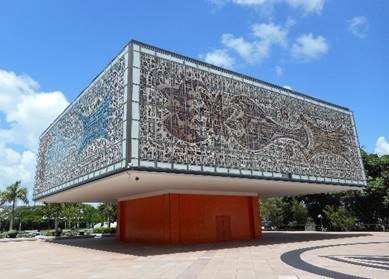
For Immediate Release
Wednesday, November 21, 2018
Contact: Sarah Revell
[email protected]
850.245.6522
Secretary Detzner Announces the Designation of Two Miami Landmarks on the National Register of Historic Places
TALLAHASSEE, Fla. –
Secretary of State Ken Detzner announced today the Coconut Grove Playhouse and the Bacardi Complex in the city of Miami have been listed on the National Park Service's National Register of Historic Places.
"These two National Register listings recognize Miami's iconic architecture and cultural development throughout the twentieth century," said Secretary Detzner."Originally designed as a 1920s movie theatre, the Coconut Grove Playhouse became an important cultural space in the mid-century period and beyond, and is a prominent fixture in downtown Coconut Grove. Likewise, the breathtaking architecture of the Bacardi Complex represents the contributions of Cuban immigrants to Florida during the mid-twentieth century, fusing art and architecture to create a striking visual impact."

Coconut Grove Playhouse
The Coconut Grove Playhouse is a three-story Mediterranean Revival style theater located at the northwest corner of Main Highway and Charles Avenue near the heart of downtown Coconut Grove. The building was originally designed by the popular and prolific Miami architecture firm of Kiehnel and Elliott, noted designers of other local landmarks such as El Jardin in Coconut Grove, the Scottish Rite Cathedral in Miami and the Coral Gables Congregational Church. The building first opened in 1927 as a silent movie theater, but that use was short-lived due to the introduction of "talking pictures" that same year. The theater was remodeled in 1955 to become a playhouse under the direction of oilman George Engle, who hoped to turn the building into a national entertainment landmark. The redesign was accomplished by mid-century Modernist architect Alfred Browning Parker, and the playhouse became the center of live theater in Miami for nearly two decades.
Under the direction of George Engle, and later Zev Buffman, the Coconut Grove Playhouse hosted many iconic productions, including the American premiere of Samuel Beckett's classic play Waiting for Godot at the theater's reopening in January 1956. From the beginning, the playhouse served as a staging and testing ground for productions aimed at Broadway audiences, and playwrights such as Tennessee Williams saw the Coconut Grove Playhouse as a productive location for staged performances. In addition to its importance to Miami entertainment, the building is significant for its Mediterranean Revival exterior. This style of architecture was popular during the city's 1920s boom, and architects Keihnel and Elliot are credited with introducing the style to Miami.
After passing through many owners, the State of Florida acquired the Coconut Grove Playhouse in 1980. It closed in 2006, 50 years after first opening as a playhouse. Currently, Miami-Dade County leases the building from the state in partnership with Florida International University and GableStage, and rehabilitation of the theater is in the planning stages. The playhouse has seen a number of interior and exterior changes through the years, but the significance of the playhouse to the Coconut Grove community remains strong.

Bacardi Imports Tower
The Bacardi Complex, located along Miami's Biscayne Boulevard within the city's Edgewater neighborhood, was first built in 1963 to serve as the headquarters for Bacardi Imports, the American arm of the well-known Bacardi spirits company. Following the post-Revolutionary Cuban diaspora of the 1960s, Bacardi transitioned a large part of their commercial activity to the United States. The complex consists of two International-style buildings built in a plaza constructed on top of an underground parking garage. The complex is a distinctive and iconic feature of downtown Miami's architecture. The two buildings in the Bacardi complex are notable for their uses of steel and glass, each featuring imaginative cantilevered overhangs as the bulk of each building. The 1963 Bacardi Imports Tower is decorated with over 28,000 blue and white azulejo tiles painted and assembled by Brazilian artist Francisco Brennand.

Bacardi Imports Administration Annex
The 1970 Bacardi Imports Administration Annex building's four walls are entirely defined by stained-glass windows manufactured by French artists Gabriel and Jacques Loire based upon a painting by German artist Johannes Dietz. Both buildings are notable for their artistic forms and the way they embrace international influences within architecture and art to create visually impressive works.
While Bacardi no longer owns the complex, the corporation has nonetheless left a permanent mark on the site with their bat logo emblazoned onto the central plaza. The Bacardi Complex is currently owned by the National YoungArts Foundation, a non-profit charity which encourages youth artistic achievement. A recent grant project through the Florida Division of Historical Resources to the University of Florida School of Architecture recognized these buildings as one of the top 50 flagship mid-century modern structures in Florida.
# # #
About the National Register of Historic Places The National Register of Historic Places is a list maintained by the National Park Service which includes historical or archaeological properties including buildings, structures, sites, objects, and districts, that are considered worthy of preservation because of their local, statewide and/or national significance. Nominations for properties in Florida are submitted to the National Park Service through the Florida Department of State's Division of Historical Resources. Florida has over 1,700 listings on the National Register, including 295 historic districts and 175 archaeological sites. There are more than 50,000 sites contributing to the National Register in Florida. For more information, visit flheritage.com/preservation/national-register. For more information about the National Register of Historic Places program administered by the National Park Service, visit nps.gov/nr.
About the Florida Department of State's Bureau of Historic Preservation
The Bureau of Historic Preservation (BHP) conducts historic preservation programs aimed at identifying, evaluating, preserving and interpreting the historic and cultural resources of the state. The Bureau manages the Florida Main Street Program, and under federal and state laws, oversees the National Register of Historic Places program for Florida, maintains an inventory of the state's historical resources in the Florida Master Site File, assists applicants in federal tax benefit and local government ad valorem tax relief programs for historic buildings, and reviews the impact that development projects may have on significant historic resources. For more information, visit flheritage.com/preservation.
